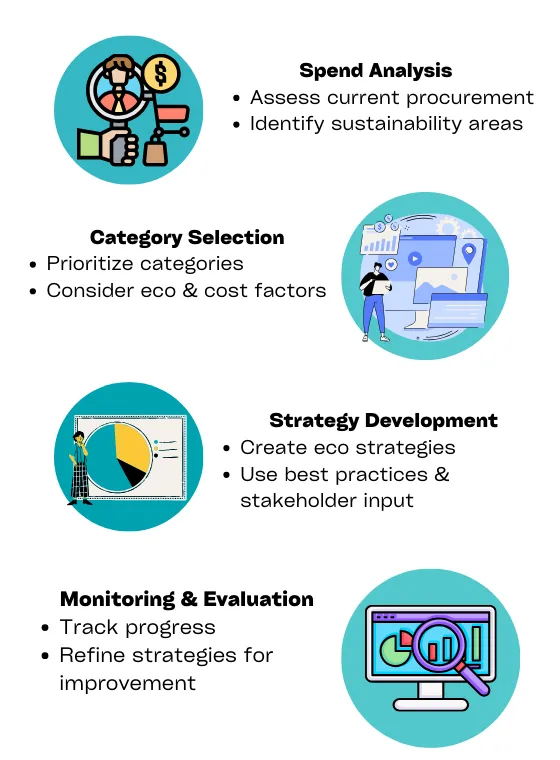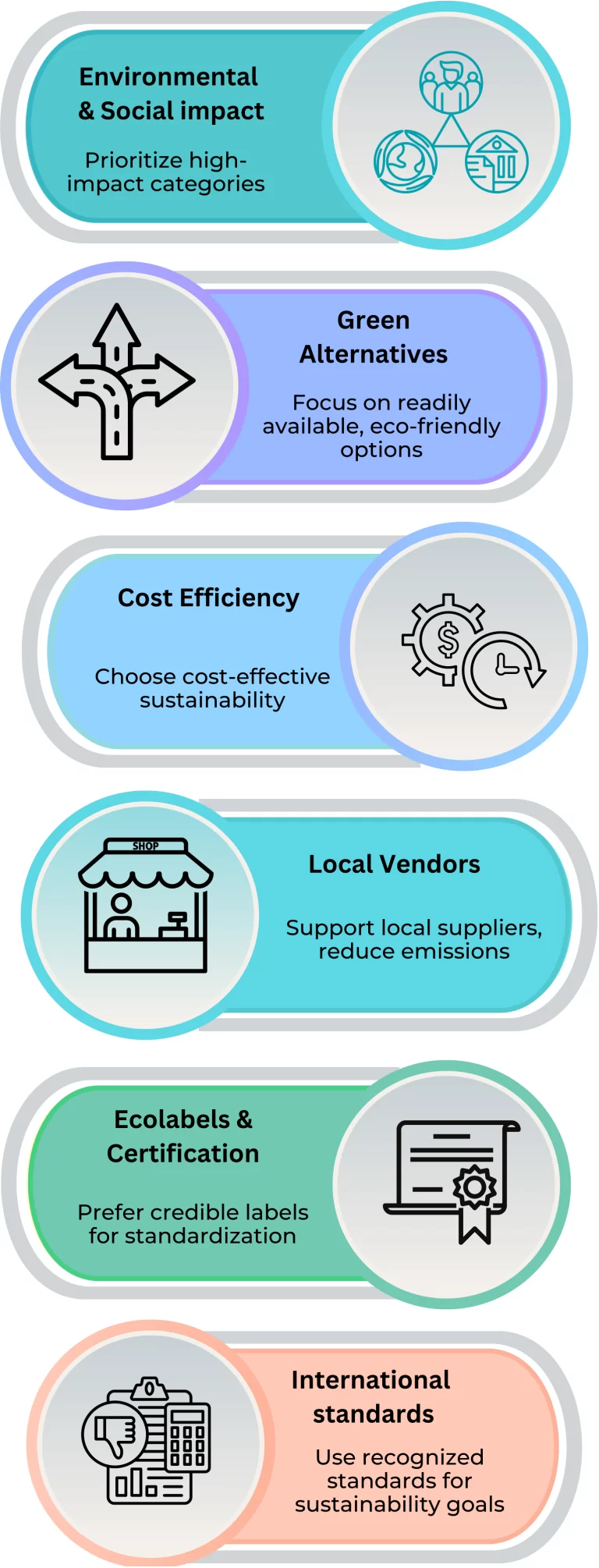
Crafting a Solid Baseline Without Historical Data: The EmpoweringCPO Way
What is Baseline? Baseline preparation is one of the most important phases during any Strategic Sourcing process.

Sustainable Procurement is the process of evaluating and selecting products and services beyond traditional financial considerations, taking into account environmental and social factors. This holistic approach helps organizations make responsible choices that minimize negative impacts on the environment, promote social well-being, and drive long-term value for businesses and society as a whole. The importance of sustainable procurement management has grown significantly in recent years, as organizations recognize the role it plays in managing risks, fostering innovation, and achieving competitive advantage in an increasingly resource-constrained world.
The world is facing an unprecedented challenge in addressing climate change, with major countries committing to reducing greenhouse gas emissions and limiting global warming. As a result, procurement organizations have a critical role to play in helping achieve these goals by making responsible purchasing decisions. By incorporating sustainability criteria into their procurement processes, organizations can contribute to reducing carbon footprints, minimizing waste, and promoting responsible production and consumption practices throughout their supply chains.
To effectively address climate change and other environmental challenges, procurement organizations must transition from traditional procurement practices to green procurement strategies. This shift requires a comprehensive understanding of the environmental and social impacts of products and services, as well as the ability to evaluate options based on life cycle costs and benefits. Green procurement organizations prioritize environmental goals, such as reducing emissions and waste, conserving resources, and promoting circular economy principles, while also considering social factors, like fair labor practices and community development.
Implementing sustainable procurement involves setting clear goals, such as reducing carbon emissions, minimizing waste, and promoting ethical labor practices. Achieving these goals requires procurement organizations to overcome various challenges, such as limited access to sustainable products and services, higher initial costs, and complex evaluation processes. Organizations must also navigate evolving regulations, standards, and certifications, as well as the need to engage stakeholders and build a culture of sustainability within their teams. By addressing these challenges and adopting sustainable procurement strategies, organizations can contribute to a more sustainable and resilient future for all.
The EmpoweringCPO Sustainable Procurement Strategy Process is a comprehensive approach designed to help organizations transition from traditional procurement practices to sustainable procurement. This process involves evaluating current procurement activities, identifying opportunities for improvement, and implementing strategies including managed procurement services that align with environmental and social goals. By leveraging EmpoweringCPO’s expertise and tools, organizations can effectively integrate sustainability considerations into their procurement processes, ensuring long-term value and resilience.
The EmpoweringCPO Sustainable Procurement Strategy Process is divided into four to six phases, each lasting approximately six months. This phased approach allows organizations to incrementally improve their procurement practices while minimizing disruptions to ongoing operations. The phases are as follows:
Conduct a thorough assessment of current procurement activities to identify areas with the greatest potential for sustainability improvements.
Based on the findings from the spend analytics dashboard, prioritize categories for sustainable procurement initiatives, considering factors such as environmental and social impacts, availability of green alternatives, and potential cost savings.
Develop and implement sustainable procurement strategies for selected categories, incorporating best practices, industry standards, and stakeholder input.
Track the progress of sustainable procurement initiatives, measure their impact, and refine strategies as needed to ensure continuous improvement.
Additional phases may be added as necessary to address specific challenges or opportunities identified during the process.

Several criteria are considered when selecting categories for sustainable procurement initiatives within the EmpoweringCPO process. These criteria help organizations prioritize efforts and resources to maximize the impact of their sustainable procurement strategies. The criteria include:
Focus on categories with clear and significant environmental or social impacts, such as high resource consumption, hazardous material usage, or labor rights concerns.
Prioritize categories where sustainable alternatives are readily available and can meet the organization’s needs.
Select categories where the cost or price of sustainable products or services is equal to or lower than current options, ensuring a smooth transition and minimal financial burden.
For categories that can be supplied by local vendors, promoting economic development and reducing transportation-related emissions.
Give preference to categories with established ecolabels or certifications, which provide a credible and standardized means of evaluating sustainability performance.
In the absence of ecolabels, prioritize categories with internationally recognized standards or specifications related to sustainability goals.
By carefully considering these criteria, organizations can develop and implement sustainable procurement strategies that drive meaningful improvements in their environmental and social performance while delivering long-term value.

Traditional procurement processes typically involve several steps that form a solid foundation for procurement activities, incorporating sustainability goals requires additional interventions and considerations at each stage:
EmpoweringCPO helps organizations understand current specifications and research alternative sustainable options through preliminary market analysis. This initial planning phase is crucial for identifying opportunities to improve environmental and social outcomes while meeting the organization’s procurement needs.
EmpoweringCPO assists in shortlisting vendors with strong sustainability credentials, such as possession of ecolabels or Environmental Management System (EMS) certifications. This ensures that potential suppliers are capable of meeting the organization’s sustainability requirements and goals.
EmpoweringCPO supports organizations in developing sustainability specifications for RFPs based on applicable ecolabels and standards. By emphasizing functional requirements rather than rigid specifications, vendors are encouraged to offer creative solutions that meet sustainability goals. Additionally, any dos and don’ts during the production process, such as restrictions on hazardous materials or labor standards, are clearly outlined.
EmpoweringCPO helps organizations thoroughly review and score vendors’ responses to sustainability-related questions, in addition to other evaluation criteria. This approach ensures that sustainability performance is a key factor in the vendor selection process.
Although sustainability-related interventions during negotiations may be limited, EmpoweringCPO can help organizations maintain a focus on sustainability goals throughout the negotiation process and consider any potential trade-offs between cost and sustainability outcomes.
EmpoweringCPO advocates for the use of Life Cycle Cost Analysis (LCCA) instead of traditional TCO evaluations. LCCA takes into account costs associated with purchase, operation, and end-of-life, providing a more comprehensive understanding of a product or service’s environmental and social impacts throughout its life cycle, supported by advanced procurement analytics tools.
EmpoweringCPO is among the leading sustainable procurement companies, ensures that sustainability-related clauses are included in contracts, specifying requirements such as bulk delivery to save on transportation, delivery outside peak traffic hours, and supplier responsibility for reusing packaging materials. These clauses reinforce the organization’s commitment to sustainability and encourage suppliers to adopt more sustainable practices.
By incorporating these interventions at each step of the procurement process, EmpoweringCPO helps organizations achieve their sustainability goals while maintaining high-quality procurement practices that deliver long-term value.

Transitioning to green procurement enables organizations to better manage risks associated with environmental and social issues. By identifying and screening suppliers that may pose reputational risks, such as those using toxic materials or exploiting child labor, organizations can protect their brand image and maintain consumer trust. In addition, green procurement practices help mitigate potential disruptions to supply chains caused by environmental or regulatory changes.
As carbon-regulated markets expand, suppliers with high carbon footprints will face increased operational costs and potential shutdowns. Green procurement initiatives enable organizations to identify and engage with suppliers that have lower carbon emissions, ensuring a more resilient supply chain. This proactive approach to sustainability also helps organizations identify long-term cost-saving opportunities, as suppliers with lower carbon footprints are more likely to adapt to future regulatory changes.
Many institutional investors now consider sustainability factors, including green procurement practices, when evaluating a company’s medium to long-term prospects for return on equity. By implementing sustainable procurement initiatives, organizations can demonstrate their commitment to environmental and social responsibility, making them more attractive to investors who prioritize sustainability in their portfolio allocations.
Green procurement practices can help organizations comply with social regulations and contribute to the development of local communities. By prioritizing the use of local suppliers and implementing sustainable procurement standards, organizations can support local economic growth and build a more resilient supply chain for the future. In addition, adhering to social and labor standards within the procurement process can help organizations avoid potential legal and reputational risks.
By integrating sustainability factors into procurement decisions, organizations not only strengthen their supply chains and contribute to local community development but also position themselves as responsible corporate citizens and industry leaders.

The furniture giant IKEA has long been committed to sustainable procurement, sourcing wood from sustainably managed forests and using recycled materials in its products. The company’s “People and Planet Positive” strategy aims to become a circular and climate-positive business by 2030, which includes goals to reduce waste and increase the use of renewable energy across its supply chain.
Unilever’s Sustainable Living Plan focuses on reducing the company’s environmental footprint and improving social conditions across its value chain. As part of this plan, Unilever has committed to sourcing 100% of its agricultural raw materials sustainably by 2030. The company has also developed the Partner to Win program, which works closely with suppliers to drive sustainable practices and create shared value.
Successful green procurement initiatives require strong leadership and support from the top levels of the organization. This ensures that sustainability is prioritized throughout the company and helps to create a culture of responsibility and accountability.
Setting clear sustainability goals and key performance indicators (KPIs) allows organizations to track progress, identify areas for improvement, and communicate achievements to stakeholders.
Constant collaboration and communication with suppliers to adopt sustainable practice would supplement mutually beneficial growth. This includes supporting, training and providing resources to supplier so that they can proactively adopt sustainable practices.
Progress of sustainable procurement initiatives should be regularly monitored, reported and communicated to stakeholders not only for tracking, but also for building trust and reinforcing commitment to sustainability.

Organizations can join forces with industry peers to drive sustainability improvements across their shared supply chains. Initiatives like the Sustainable Apparel Coalition, which brings together apparel and footwear brands to reduce the industry’s environmental and social impacts, are examples of successful industry collaborations.
Engaging with NGOs, governments, and other stakeholders can help organizations address complex sustainability challenges more effectively. For example, the Roundtable on Sustainable Palm Oil (RSPO) brings together diverse stakeholders to develop and implement sustainable palm oil production standards.
Collaborating with government agencies and other public-sector entities can help organizations access resources, expertise, and funding to support green procurement initiatives. These partnerships can also enable organizations to influence policy development and contribute to broader sustainability goals.
By learning from successful green procurement initiatives and adopting best practices, organizations can drive meaningful change in their supply chains and contribute to a more sustainable future.
These technologies can help procurement professionals analyze vast amounts of data, identify patterns, and make more informed decisions. For example, AI can be used to monitor suppliers’ sustainability performance, identify risks, and predict future trends.
IoT can help track products and materials throughout the supply chain, providing real-time information on environmental and social impacts. Blockchain can enhance transparency by securely recording transactions and information, making it easier for organizations to track and verify sustainable practices.
Governments around the world are implementing more stringent environmental and social regulations, which will impact procurement practices. Organizations need to stay informed about these changes and adapt their procurement strategies accordingly.
International standards, such as the ISO 20400 Sustainable Procurement Standard, provide guidelines for organizations to implement sustainable procurement practices. As more organizations adopt these standards, procurement professionals will need to ensure their practices align with these frameworks.
Certifications and ecolabels, such as Fair Trade and Forest Stewardship Council (FSC), help organizations demonstrate their commitment to sustainability. Procurement professionals will need to stay updated on relevant certifications and incorporate them into their sourcing strategies.
With the growing importance of sustainability, some companies may engage in greenwashing – making misleading claims about their environmental performance. Procurement professionals need to be vigilant in verifying the authenticity of certifications and claims made by suppliers.
Ensuring that employees understand the importance of sustainability and are equipped with the necessary skills and knowledge is crucial for implementing sustainable procurement practices. Organizations should invest in ongoing training and development programs to build a culture of sustainability.
Sustainable procurement requires collaboration across different departments, such as finance, operations, and marketing. Organizations should promote cross-functional collaboration to ensure that sustainability goals are integrated throughout the business.
By staying informed about future trends and challenges in sustainable procurement, organizations can adapt their strategies and continue to drive positive environmental and social impacts throughout their supply chains.
Sustainable procurement plays a critical role in addressing climate change and achieving global climate goals. By considering the environmental and social impacts of the products and services they purchase, organizations can significantly reduce their carbon footprint, promote responsible resource use, and contribute to a more sustainable economy. As businesses worldwide recognize the urgency of climate action, sustainable procurement is becoming an essential component of corporate sustainability strategies.
EmpoweringCPO one of the leading strategic sourcing firms, is committed to helping organizations transition to sustainable procurement practices by providing expert guidance, support, and strategic interventions. By offering customized solutions tailored to each organization’s unique needs, EmpoweringCPO assists in identifying sustainable alternatives, shortlisting vendors with strong sustainability credentials, and incorporating sustainability criteria into the procurement process. As a partner in this journey, EmpoweringCPO helps organizations navigate the challenges of sustainable procurement and achieve their environmental and social goals.
To build a greener future, organizations must embrace continuous improvement and collaboration in their sustainable procurement efforts. By learning from best practices, staying informed about emerging trends and challenges, and working together with suppliers, industry peers, and other stakeholders, organizations can drive meaningful change in their supply chains and contribute to global sustainability efforts. The pursuit of sustainable procurement is not only a responsible business practice but also an opportunity for organizations to innovate, reduce risks, and create long-term value for all stakeholders.
These are quite recently the absolute most normal inquiries we get inquired.
With the current level of commitment from all major countries for climate change mitigation, the world is on target to warm by 2.7 degrees centigrade by the end of this century. This may lead to high extreme temperatures, ferocious weather, substantial rise in sea levels, and permanent damage to many ecosystems. Going forward, regulations will be more stringent to ensure voluntary commitments are honored. Procurement organizations worldwide can contribute a lot to this effort, and transitioning into Green Procurement organizations is the only way forward.
EmpoweringCPO can help identify categories that can be challenged in favor of greener options and can also help in selecting the right options and vendors. During the execution of a strategic sourcing project or during ongoing category management, EmpoweringCPO can introduce many procurement interventions to achieve sustainable goals.
The path adopted or option selected can be relatively better, it may not be the greenest, but can be greener compared to the product or service being sourced currently. Start by conducting a thorough spending analysis and prepare a plan for executing sourcing projects with an agenda of improving the sustainability goals of the organization. The categories are identified that should be executed in 4 – 6 phases; each phase is of 6 months.
The criteria used for identifying these categories are based on the following: Environmental or Social impacts are clear and huge; plenty of green alternatives are available; the cost or price of the sustainable product or service is lower or equal compared to that for the current specification; the focus is on categories that can be supplied by local vendors; categories for which Ecolabels are available; and, even if Ecolabels are not available, identifying categories for which International standards and specifications related to sustainability goals are available.
To achieve sustainability goals, the bids are evaluated based on life cycle cost analysis, which takes into consideration the following cost components: all costs associated with purchase like product cost, delivery, installation, and commissioning; operating costs including water, gas, spares, maintenance, employee health, social coverage, etc.; end-of-life costs like decommissioning and removal.
Vendors are evaluated for sustainable procurement based on the Non-Price parameter, along with other questions, their answers to all the sustainability-related questions are also thoroughly reviewed and scored to rank vendors.
Sustainability-related contract performance clauses include clauses related to the use of eco-friendly products, waste reduction, reduction of greenhouse gas emissions, and promoting sustainable practices throughout the supply chain.
EmpoweringCPO can help identify categories that can be challenged in favor of greener options and we can also help in selecting the right options and vendors. During the execution of a strategic sourcing project or during ongoing category management, EmpoweringCPO can introduce many procurement interventions to achieve sustainable goals. We can assist in shortlisting vendors with strong credentials for sustainability, developing sustainability specifications, evaluating vendors based on their sustainability-related answers, and selecting suppliers based on life cycle cost analysis. We can also help in developing implementation and transition plans, contracts, and performance metrics that have sustainability-related clauses.Top of Form
By ensuring that the savings projected or reported during a strategic sourcing project are actually realized, savings compliance tracking helps organizations to save money. It helps identify areas of non-compliance and take corrective action to ensure that the savings are realized.

What is Baseline? Baseline preparation is one of the most important phases during any Strategic Sourcing process.

A cartel is formed when businesses agree to act together for an anti-competitive purpose instead of competing against each other.

Spot Buying is for immediate, Ad-Hoc & one-off purchases. It’s estimated that around 40% of the company’s indirect spending is from spot buying.
Compliance management is very critical as otherwise the procurement organization may run into a scenario where there is a huge gap between realized savings and reported savings. Many procurement functions estimate large savings numbers when contracts are signed. They also invest significant time and effort in negotiating contracts for necessary goods and services, only to have a third or more of their purchasing dollars flow outside those deals. Some of the obvious fall-outs of non-compliance and maverick purchases are:
As compared to the current contract that was finalized after the sourcing process, the tool helps in tracking:
The objective of this tool is to ensure that the orders are placed only with the vendors that were shortlisted after the sourcing process and at the same price that was agreed upon and negotiated during and after the strategic sourcing process.